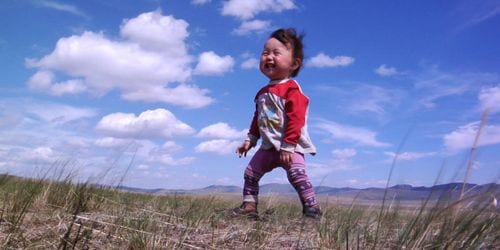
Babies opens on two Namibian babies playing next to one another. Both covet a new plaything and a squabble ensues: pushing, screaming, biting, hitting, and some dramatic tears as the “loser” collapses in defeat, peeking up just once to make sure her mother is bearing witness to her tragedy. Though the girls are sitting in the dirt and playing with rocks and discarded plastic water bottles, theirs is an encounter that anyone who has ever spent five minutes with two toddlers might recognize.
And this is Babies‘ point, that our commonalities as human beings, at least in these early stages of life, far outweigh our differences. Directed and filmed by Thomas Balmès over several years, the movie tags along during the first year of life of four babies from four distinctly different locations: Namibia, Mongolia, Tokyo, and San Francisco. There is no narration and very little captured conversation. Long takes (some over three minutes long) make us wait for something to happen. It puts the viewer in the place of any adoring parent, watching over her child with unabashed fascination. It is also a welcome change from the usual rapid-fire visual onslaught.
Still, all filmmaking is manipulative. By focusing on the babies, most scenes include only parts of parents’ bodies or exclude the parents outright. One effect is that the babies often appear to be alone (though they aren’t) which in turn amps up the audience’s connection with them. So, when Bayar in Mongolia is crawling amid a bunch of cattle that come dangerously close to stepping on him, we want to intervene since no one else is. Our response underscores our sameness, too, along with the families in the movie.
Such investment helps to shape our responses to the vastly different locations, all beautifully presented. We see similarities among the babies’ home environments (daily routines of eating or bathing), and the children themselves observe and mimic their parents (that first scene of the children banging rocks together is them emulating their mother grinding ochre and clay). Their motor skills and language skills develop; they become aware of themselves as entities separate from their mothers. Indeed, no matter how different their specific locations, the most fascinating moments in the film come from the unavoidable comparisons. Ponijao’s family lives in a very dusty environment and has to walk a considerable distance to water; her mother licks the newborn’s eyes and face to keep the dirt out of them. This shot is juxtaposed with one of Hattie enjoying a shower or a dip in the hot tub with her mother.
The film also structures a lovely symmetry between some images, as when Hattie makes a big production of peeling her own banana in one scene, while in another Ponijao sits by her mother as she skins an animal. We can see connections in cuts between Tokyo, where Mari throws a flopping, screaming fit when she is frustrated by a toy, and Mongolia, where Bayar (who is tied to a bedpost to keep him from wandering too far) determinedly works to get hold of a roll of toilet paper he gleefully unravels and eats. Bayar and his brother are mostly left to entertain themselves in the family’s yurt while their parents tend to the cattle. Mari and Hattie, on the other hand, are constantly toted along to play dates and play groups and seem to be far less able to entertain themselves. All these images help us see the ways babies are alike even in their differences.

![Call for Papers: All Things Reconsidered [MUSIC] May-August 2024](https://www.popmatters.com/wp-content/uploads/2024/04/all-things-reconsidered-call-music-may-2024-720x380.jpg)



